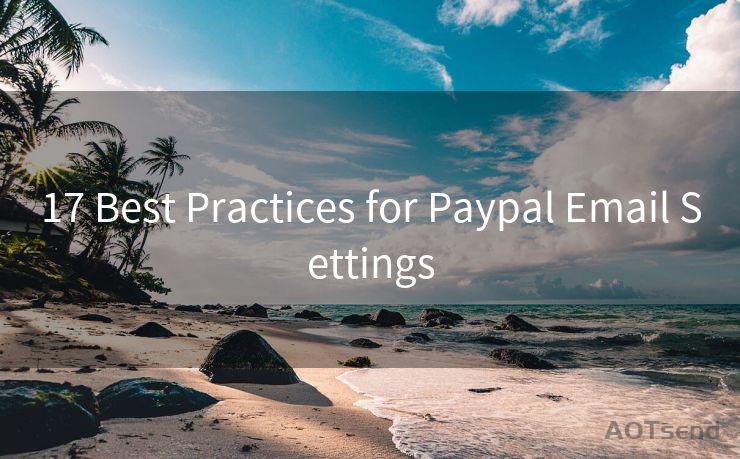17 Best Practices for Paypal Email Settings




When it comes to online payments, PayPal stands as a giant in the industry. With millions of users worldwide, it's crucial to ensure your PayPal email settings are optimized for security and convenience. Here are 17 best practices for configuring your PayPal email settings to enhance your user experience and protect your account.
1. Use a Secure Email Address

Start by using a unique and secure email address for your PayPal account. Avoid using a public or easily guessable email. This adds an extra layer of security to your account.
2. Verify Your Email Address
Immediately after signing up, make sure to verify your email address. PayPal will send a verification link to your inbox. Clicking on this link confirms your email address and activates your account.
3. Enable Two-Factor Authentication
For added security, enable two-factor authentication (2FA). This requires an additional code, sent to your email or phone, whenever you log in. It's a powerful way to prevent unauthorized access.
4. Monitor Email Notifications
Keep a close eye on email notifications from PayPal. These emails alert you to account activity, such as transactions, password changes, or updates to your account.
5. Customize Your Email Preferences
Within your PayPal settings, you can customize your email preferences. Choose which notifications you want to receive and how often. This helps keep your inbox organized and reduces clutter.
6. Beware of Phishing Emails
Be vigilant against phishing emails that claim to be from PayPal. Always check the sender's email address and never click on suspicious links or attachments.
7. Use a Strong Password
A strong, unique password is essential for your PayPal account. Combine letters, numbers, and symbols to create a robust password that's difficult to guess.
8. Update Your Email Password Regularly
For extra security, consider updating your email password periodically. This reduces the risk of your account being hacked, which could potentially lead to unauthorized access to your PayPal.
9. Link Your Bank Account Securely
When linking your bank account to PayPal, ensure you're doing so securely. PayPal will send a confirmation email once the account is linked. Verify this email to ensure the process is complete and secure.
10. Utilize PayPal's Security Features
Take advantage of PayPal's built-in security features, such as fraud monitoring and Seller Protection. These tools help keep your transactions safe and secure.
11. Keep Your Contact Information Updated
Regularly update your contact information, including your email address, to ensure you receive important notifications promptly.
12. Avoid Public Wi-Fi for Transactions
When accessing your PayPal account or making transactions, avoid using public Wi-Fi. These networks are often unsecured and can expose your personal information.
13. Log Out After Each Session
Always log out of your PayPal account after each session. This prevents unauthorized access if your device is left unattended.
🔔🔔🔔
【AOTsend Email API】:AOTsend is a Managed Email Service for sending transactional emails. Support Email Types: reminders, authentication, confirmations, notifications, verification codes, invoices, password resets, account activations, billing statements, two-factor authentication (2FA), and one-time passwords (OTP) emails, etc. $0.28 per 1000 Emails. 99% Delivery, 98% Inbox Rate.
You might be interested in:
Why did we start the AOTsend project, Brand Story?
What is a Managed Email API, How it Works?
Best 25+ Email Marketing Platforms (Authority,Keywords&Traffic Comparison)
Best 24+ Email Marketing Service (Price, Pros&Cons Comparison)
Email APIs vs SMTP: How they Works, Any Difference?
14. Check Your Account Regularly
Regularly log in to your PayPal account to check for any unusual activity. This helps you identify and report any suspicious transactions promptly.
15. Contact PayPal for Help
If you encounter any issues with your email settings or account security, don't hesitate to contact PayPal's customer service for assistance.
16. Educate Yourself on PayPal Policies
Stay informed about PayPal's policies and procedures. This includes understanding their privacy policy, user agreement, and acceptable use policy.
17. Stay Vigilant
In conclusion, the key to securing your PayPal account lies in staying vigilant. By following these best practices for email settings and maintaining a proactive approach to security, you can ensure a safe and enjoyable experience with PayPal.
Remember, security is an ongoing process, and it's essential to stay updated on the latest security measures and threats. By implementing these 17 best practices for PayPal email settings, you're taking significant steps to protect your financial information and transactions.




Scan the QR code to access on your mobile device.
Copyright notice: This article is published by AotSend. Reproduction requires attribution.
Article Link:https://www.mailwot.com/p3481.html



